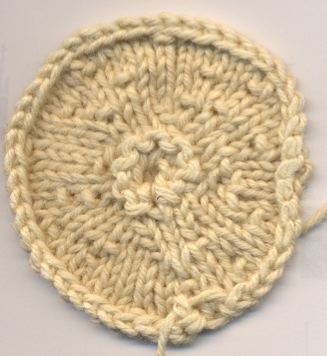Knitting Circles -- Not the Pi Shawl
Elizabeth Zimmermann's Pi Shawl has a bit of a cult following among knitters of circular shawls. While I haven't actually knitted one, I can't believe that it would lie flat without serious blocking. This is how Traditional Knitted Lace Shawls describes the method:
And so I present my method for knitting a circle that lies relatively flat, or at least as relatively flat as something knit entirely in stockinette can be:
 CO some stitches on dpns. Join for working in the round.
CO some stitches on dpns. Join for working in the round.
Rnd 1: k, inc 4 sts relatively evenly spaced
Rnds 2 - 4: repeat rnd 1
Rnd 5: k, inc 5 sts relatively evenly spaced
Repeat rnds 1-5 until circle is desired size, switching to a circular needle as desired.
Perfectionists may choose to inc 4 instead of inc 5 in rnds whose number is divisible by 100.
The reason that the increases are linear (i.e. inc 4.19 sts every rnd) is that the number of sts is a linear function of the circumference, which is a linear function of diameter, which is a linear function of the number of rnds. As a knit stitch has height:width as 2:3, the number of sts to increase each rnd is 2π(2/3). For some other stitch, multiply 2π by its height:width ratio to determine how many sts to increase each rnd in order to knit a circle.
[E]ach circle represents an increase round, a round in which the stitch count is doubled. The distance between increase rounds (the rate of increase) is increased progressively. This shaping is based on the formula cicumference = πr2. The number of stitches is doubled on each increase round and the distance between two increase rounds is double the distance between the previous two increase rounds.So you cast on some stitches, increase in every stitch, work even for a while, increase in every stitch, work even twice as long as before, etc. This means that if you continue forever, you will have arbitrarily long stretches where you work even. This will not lie flat! (Do I even need to point out that C = πd and A = πr2?)
And so I present my method for knitting a circle that lies relatively flat, or at least as relatively flat as something knit entirely in stockinette can be:
 CO some stitches on dpns. Join for working in the round.
CO some stitches on dpns. Join for working in the round.Rnd 1: k, inc 4 sts relatively evenly spaced
Rnds 2 - 4: repeat rnd 1
Rnd 5: k, inc 5 sts relatively evenly spaced
Repeat rnds 1-5 until circle is desired size, switching to a circular needle as desired.
Perfectionists may choose to inc 4 instead of inc 5 in rnds whose number is divisible by 100.
The reason that the increases are linear (i.e. inc 4.19 sts every rnd) is that the number of sts is a linear function of the circumference, which is a linear function of diameter, which is a linear function of the number of rnds. As a knit stitch has height:width as 2:3, the number of sts to increase each rnd is 2π(2/3). For some other stitch, multiply 2π by its height:width ratio to determine how many sts to increase each rnd in order to knit a circle.
![Do You? I [heart] Wool. Do You?](http://img.photobucket.com/albums/v314/rudbeckiahirta/iheartwool_88x37.gif)

